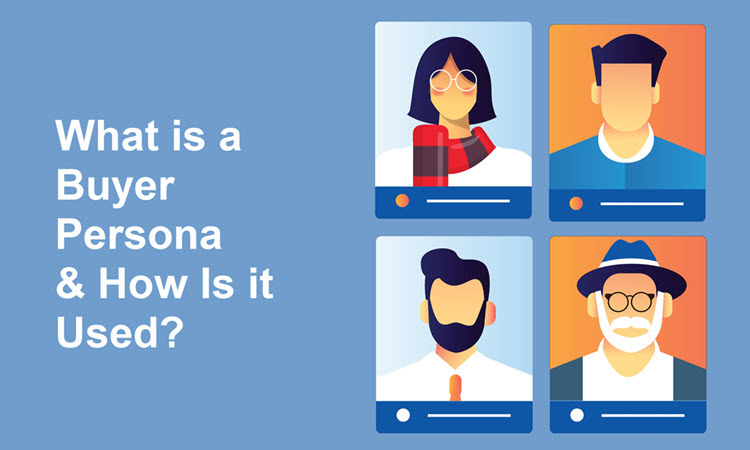You’ve definitely heard the term “buyer persona” if you’ve ever been near the world of marketing. Marketers toss it out ever-so-casually as if everyone knows what it is.
But what is a buyer persona, after all?
This article explains what a buyer persona is, which types of buyer personas exist, and how each business owner can easily create a buyer persona.
What is a Buyer Persona?
A buyer persona is a semi-fictional personality representation of your ideal buyers. It helps marketers identify qualified prospects and focus marketing efforts and product innovation towards target customers.
On a business strategy level, buyer personas help ensure that all business activities are focused on acquiring and serving the target audience. Although it does seem like an obvious thing, it isn’t as simple as it sounds.
Most commonly, when choosing products or services, people naturally gravitate towards brands they trust and feel connected to. For brands, the best way to establish a connection and trust with customers is to show genuine understanding and concern through product and marketing communication. And for this, it’s essential to know your customers in the first place.
Buyer personas help businesses understand the needs, wants, and desires of their customers. These personality traits are the guides for businesses to stay centered on customer needs.
Why Do You Need Buyer Personas?
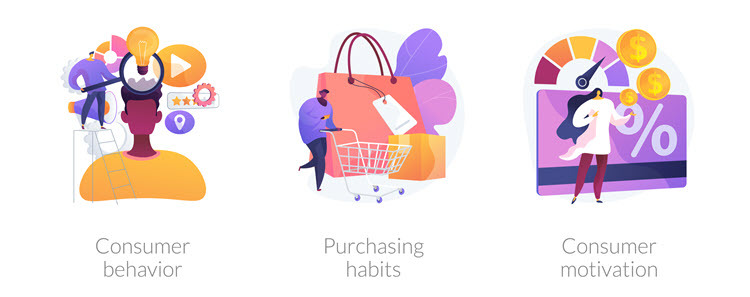
Buyer personas make it easier for your business to personalize products, services, and communication as per the target customers’ needs, behaviors, and pain points.
For example, you might already know that your target customers are bikers, but do you know what their interests are? Why do they ride? Is bike riding their hobby or their profession?
To gain a complete understanding of what makes your target customers’ minds tick, it’s crucial to create detailed buyer personas. To-the-point personas are based on market research and customer insights (collected via customer feedback, surveys, and interviews).
Depending on your industry and range of products, you can have as few as two or three buyer personas, or as many as 20 or 30. If you are just starting a business, start small and keep adding more personas as you move forward.
Are Buyer Personas Negative Too?
Yes, there are negative buyer personas too. These personas are a representation of people you don’t want as a customer.
For example, for a brand that sells biking gear, the negative buyer personas could be two-wheeler owners who use motorcycles to commute within the city or people who don’t fall into the disposable income segment that your brand wants to target.
Negative buyer personas also include customers who are too expensive to acquire. This can be due to low average sale figures, a tendency to churn, or their unlikeliness to become loyal customers.
Even so, many established brands and brands backed by investors try to acquire some negative personas in their quest to obtain a higher and wider share in the market.
Note: Learn everything you need to know about the role of buyer's personas in an omnichannel customer journey.
How to Use Buyer Personas for Marketing
At the most basic level, detailed buyer personas enable you to personalize your marketing efforts for different segments of potential customers. The marketing communication team can use these personas to come up with social media posts, website content, buyer guides, advertisement banners, etc.
72% of consumers say that they’ll only interact with personalized messages. This can’t happen without buyer personas.
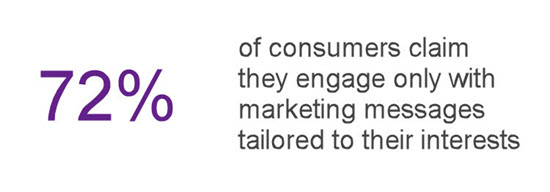
Let’s take an example of a food delivery app like Uber Eats. Instead of sending push notifications for meat dishes to all the users, the app can segment users by their eating preferences such as vegetarians, non-vegetarians, and vegans, and personalize the notifications.
Combined with the customer lifecycle stage, buyer personas and lead gen platforms enable you to hyper-personalize your campaigns, which results in greater ROI. Furthermore, if you pick out the “bad apples” (read negative personas), you can achieve a very low cost per lead generation.
Spotify, for instance, leverages buyer personas extremely well. It personalizes the ad campaigns based on the music the free plan user listens to. The relatability of the ad can push them to buy the premium version of the app.
Types of Buyer Personas

There isn’t any predefined list of buyer personas you can choose from, nor is there an ideal number of buyer personas you should have for a successful marketing strategy. It’s because, irrespective of the market stage, every business is unique to some extent.
There are always some differentiating factors that distinguish businesses from one another. And this is why some buyer personas will be unique for your business.
Having said that, below is a list of high-level types of buyer personas:
- Decisive buyers
- Consensus buyers
- Socially inclined buyers
- Skeptical buyers
- Analytical buyers
Once you delve into creating a buyer persona, you’ll notice how unique and company-specific it gets.
How to Create a Buyer Persona
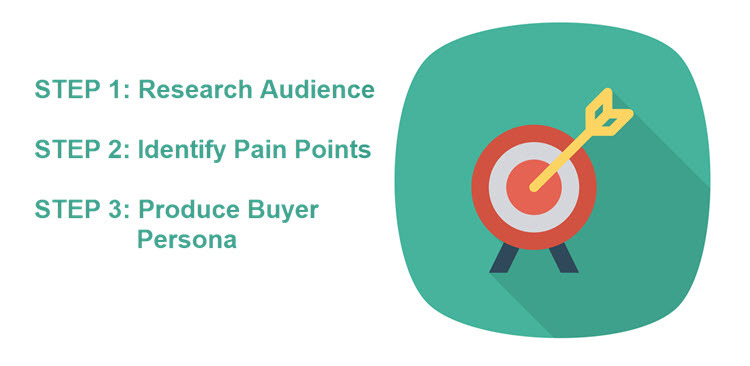
To create a buyer persona, you need to understand the factors that impact consumer purchase behavior. To get a clear picture of your customer, perform the following steps.
Step 1: Research Your Audience
Conducting thorough research provides information that ensures your buyer persona is as accurate and detailed as possible. Gather information about your audience from these sources:
- Existing customer base. Focus on returning customers since your products match their needs.
- Social media metrics. Learn who your potential customers are and how they discovered your brand. Use Google Analytics, Facebook Audience Insights, Instagram Insights, LinkedIn Insights.
- Social listening tools. With the help of tools such as Buffer, Brandwatch, Keyhole, Hootsuite Insights, you can find out what impression your brand leaves on a wider audience.
During your research, you will determine all or most of these audience factors:
- Age. Consumers in different life stages have unique needs. For example, young people look for trendy clothes while seniors prioritize comfort.
- Location. The success of your sales largely depends on the local climate and consumer trends. For example, selling rubber rain boots in the UK makes sense since locals experience 133 days of rain or snow annually.
- Type of residence. Customers make purchase decisions based on their type of residence. A person living in an urban apartment won’t be interested in gardening tools.
- Employment status and position. A customer’s employment status impacts their priorities and spending power. Unemployed people approach purchases carefully. Employed people spend more money in general, both on long-term investments and impulsive purchases.
- Interests. Every person has a set of interests and hobbies unique to them which influence their shopping habits. If you’re selling yarn, you want to target people who like to knit or crochet.
- Number of household members. Consumer priorities change as the number of household members changes. Large families spend more on household essentials and avoid unnecessary impulsive purchases. If you’re selling luxury items, it doesn’t make sense to target a customer coming from a large, low-income household.
- Spending power. A person’s spending power is the main factor that drives their purchase decisions. Your research will unveil how much your buyer persona is willing to spend on the products or services you’re offering. Adjust your prices according to those results. If you can’t lower your prices and your buyer persona can’t afford to buy from you, you’re targeting the wrong audience or offering an underperforming product.
Not every buyer persona has to contain all elements. Choose those that help you understand the type of customer you want to attract.
B2B companies should be aware of:
- The size of businesses they are targeting. Start-up companies have different needs and a limited budget compared to enterprise-level brands.
- The decision-maker in the company. Your product might be useful to end-users, but if they don’t have the power to decide on the purchase, you don’t want to target them.
Step 2: Identify the Pain Point of Your Buyer Persona
Whether your buyer persona is a consumer or business, you must identify their pain point. What problem is your ideal customer facing? Is it a personal issue or a work-related matter?
Identifying the pain point is crucial because your goal is to help your customers overcome their difficulties by providing the perfect solution. If most products and services in your niche are expensive, your advantage will be a competitive price. If your competitor’s software features an unfriendly user interface, you should invest in user experience and advertise it as your strength.
Finding the pain point leads to product adjustments, sales and marketing strategy improvements, and sales increases.
Step 3: Create the Buyer Persona
Now you are ready to create your ideal buyer’s profile. Approach the task as you would approach writing a resume for a fictional character. Use the results of your research and include any information that helps your team understand and relate to your ideal customer.
For example, if you are a custom shoe manufacturer, your ideal buyer persona could be a forty-year-old woman called “Active Sue” who:
- Leads an active lifestyle.
- Hikes and goes to the gym in her free time.
- Has two dogs she walks regularly.
- Has two kids she takes to school.
- Earns $70,000 annually.
- Doesn’t own a car but walks, cycles, or uses public transportation instead.
- Struggles to find comfortable, elegant shoes for work that are her size (US 11) and is thus forced to wear men’s shoes.
The final product should look like this.
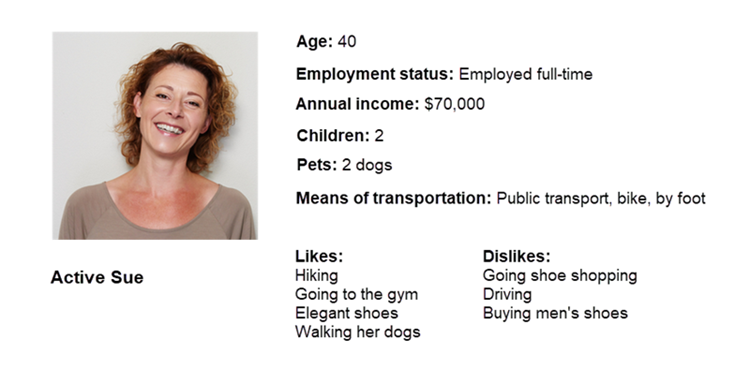
Should Small Businesses Bother Creating Buyer Personas?
Buyer personas are essential for an effective business strategy. However, there is a claim that small businesses or solopreneurs don’t have the necessary resources to create buyer personas and, hence, they aren’t necessary for them. In addition, some small businesses believe that they know who their customers are.
So, should small businesses just skip creating buyer personas?
Let’s understand the answer with an example. Imagine you’re a self-employed Yoga teacher. You have your own website and a blog where you regularly share useful tips for staying fit. You’d obviously want more customers who are or can be interested in hiring a Yoga teacher, and creating buyer personas will help narrow your focus on marketing to these people.
Based on this, you can now create more personalized blog posts that are relevant to your target audience.
Takeaways
Buyer personas are fictional characters that represent your ideal customers and help your business with marketing communication and product or service innovation.
Your business exists because of your customer needs, and buyer persona is your key to finding these needs.
